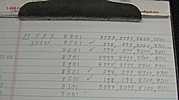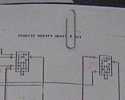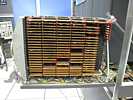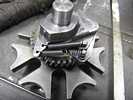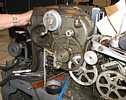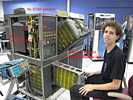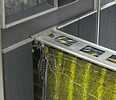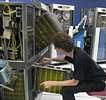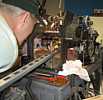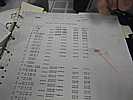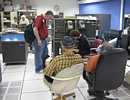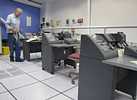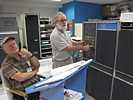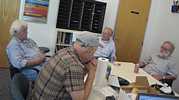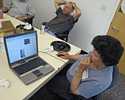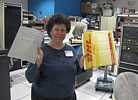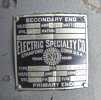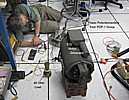Schedule July 2007
return to main 1401 Restoration Page
go to Team Bios
Contents:
Wed July 04 - general,
Wed July 11 - general,
Sat July 14 - 2nd Sat. - Volunteer Day
Wed July 18 - general,
Wed July 25 - general,
Sat July 28 - 4th Sat.
Wed July 04 - general
I called Ron telling him of this bug, and he said there was still a problem involving the 8,000 memory boundary.
Unfortunately, this did not exactly fit my bug as I started pouring text starting 3,000 up, and
got a roll-over of the index register (X3=3,999) at memory location 7,000.
Ron said that when you add or subtract something from an X Register,
the X Register has to have a word mark in the high order position, as that is the
B-Operand. (I had assumed that a word mark in either A or B operands terminated the operation.)
So Ron helped me experiment. I put in a little three instruction through the front panel -
I won't say how long to took to get my 10 thumbs working correctly.
After some experimentation, we found that Ron was correct :-((
So I patched the patched Multiple Big Print demo program to place word marks in the high characters of the X-Registers -
but the roll-over problem in the program did not go away.
Wed July 11 - general
Saturday July 14 - 2nd Saturday - Volunteer day - free food
Just how can this happen? Allen insisted the blanks were not on the tape -
Then the problem vanished - poof -
Of course, one can say "don't open that gate". But of course, most of us have been bitten by
"Murphy's Law" (Things will fail at the most inconvienent time!! Preferably during a VIP demo
or a payroll run.) We want to get to the root of this thing before it gets to us!!
Tim mentioned the unpassivated junction edges of the older construction techniques.
Like the alloy type used so much in our machine had a exposed ?base/emmiter/collector? junctions that
could easily get contaminated.
Wed July 18 - general
Here's a vid of his running tape diagnostics, loaded from tape, run from tape:
Another weird thing was that after running some of Van's tape programs, the "2" opcode (print) wouldn't work, nor would the "print storage" feature print anything; power-cycling the machine brought "2" back to live, as well as print storage. Van would run something else, then occasionally the "2" opcode wouldn't work, but it came back after power-cycle (we only power-cycled twice to be sure there was cause and effect.). We didn't try to track this down, or to figure out which of Van's programs tickled this, because Van was working hard on the tape bug. One important detail: the machine just stopped at the "2" opcode - just like it does on a "1" opcode when it's waiting for cards (normal, so put in cards) - but for printing, it seemed as if some sort of "printer ready" bit was not getting back to the main CPU or something like that.
We tried for a while reading back a load-mode record from tape, and only got two characters: an "A" bit in the first character, and a Group Mark in the 2nd; no other characters, and these two were not correct. We tried this several times.
Then I suggest trying low density, and that worked better. The video, above, and most of the tests, were in low density (the exact density of the 729-V drive is determined by a switch on the 1401's diagnostic panel - we had it in the most counterclockwise setting of 556 bpi. It would be interesting trying these again at 200 bpi.)
Van wrote a couple of pages in the log describing what he observed from all his various tests.
I suggested that he come up here more often - 'cause he was sorrta like a guy who had been in the desert for long time and finally got a sip of water...
Best -Mike
Wed July 25 - general
Received from Van Snyder, Monday July 23, 2007 - DFT 5310, ... -
From Karl Bleher (Sindelfingen, Germany) July 24, 2007 - backplane power cracks -
From Allison Akbay (CHM Registrar) - to Frank King - July 25, 2007 - Werner, Oregon shipment -
The 1401 team members requested that the following materials be transferred to be used in restorations:
The team requests that the following documents be made available to the team as soon as possible:
In addition, when passing the machines given to the Museum by the Museum of American Heritage
the team members mentioned they would also like to know the feasibility of having the IBM 403
from that collection transferred for use in restorations.
Ron, Bob, Joe, and Judith thank you for your help and please let me know if any of the above
is incorrect. If the list of items you would like transferred to restorations is correct
please use the forms provided by Alex and Dag to officially request the transfer. This might
seem buearocratic but using the form will make sure that everyone who needs to know is told
in writing so that a decision can be made by the curatorial staff and the machine official
transferred out of the permanent collection and into the study collection.
Thank you again for your help.
Sat July 28 - 4th Sat
E-mail received:
Van Snyder DFT 5310, ... -
Karl Bleher backplane power cracks -
Allison Akbay Werner, Oregon shipment -
Ron Williams will be there - so its an official work day ;-))
The left image shows the inputs, there was no change in the output of the defective card.
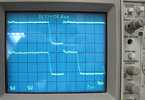
This is the card we used to replace the no output gate

And here is the good output of the replacement card.
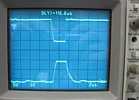
See how easy it is???
And Ron can now do a Storage Scan with out getting alarms :-))

Being continuously reset by this handy tooth pick :-))

And Tim Coslet has another (CJWF) card to fix - this one looks easy :-))
Here is (Bob's) copy of the IBM 514 Summary Punch - the physical punch mechanism is apparently identical
with our 513. Looks as though I should make a shop copy !!

and the outside of the gear case

Ya know, It just ain't fair !!
The program works just fine if there are less than 4,000 characters of text - including blank lines and spaces.
The following report is from Ron Williams
Allen got right to work on the 729 tape problem. This is Allen with the scope he used while
fixing 729s in the old days. (A year or so ago we had to replace a transformer in it - )

First a problem that popped up and then disappeared, was that
- card images copied from the card reader to magnetic tape
- then read back from tape to the print buffer
(got that?) appeared on the printer to have lots of leading blanks
and that he was not sending leading blanks back from the tape units analog amplifiers.
and Ron couldn't figure how he was padding leading blanks into the printer buffer.
- we punched up some cards with numbers and letters not containing the A bit
- examined the resulting printouts
As Allen left for the day, he said that if we left the tape drive in it's current condition,
we would not have any trouble
- The tape drive was in the turned off condition !!
- Don't you think Allen deserves the teasing we give him?
- Of course, he gives as good as he gets ;-))
-- (Van helps with the SIMH simulation of the 1401)
Here is the ultimate "abuser"/"fixer" relationship. Van is using an 026 keypunch,
and Joe is fixing an overheating 026 keypunch motor. They enjoyed each other's company.

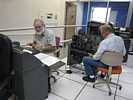
While the keypunching was going on, Ron Williams discovered the most sensitive place for causing the
machine halts last Saturday - It was *not* at the hinge, it was at pin 11 in the
furthest column from the hinge. :-| - I looked like an incomplete cold solder - wiggle the red wire a little -
and the machine will halt in an illegal state.

Van said that when he had visited Sindelfingen, Germany, Hintz told him that the Germans had the same problem -
solved by wirewraping 3,000 power bus pins.
Probe now on pin 10

We decided that to solve the immediate problem, "we" would re-solder the defective pin.
Here is Ron, on his prayer rug. making sure the job is done right this time !!!

The printer failed to print many numbers and letters, leaving
spaces where the ink should have been. Analysis of the missing characters revieled that if bit 4 was on
in the character, the printer would not print any character in that position. Ron had another task.
Apparently he solved it during the afternoon.
This seemed doable and would alleviate the need for a working tape system in assembling Autocoder decks for the
the 1401 - like we don't have enough unfinished projects now ;-))
But having to keypunch punch long complex object decks to make interesting software is
not a "good thing".
Thanks Ed for staying long enough for me to come over and meet Van on Wednesday [about 4:00]. I think Van would have stayed there all night if he could, but I had to leave, so we locked up at 9:15 pm.
http://web.1401.org/2007-Jul/Van_Snyder_Tape_test_2007-Jul-18.mov 36,585,610 bytes
After numerous tries, it worked for a while; note that test ends in a STAR error - we've seen this before.
From Bob Feretich - 7/19/2007
The high density (800 bpi) oscillator card was removed from the 1401 TAU
and placed in the "Bad Card" box to be repaired several months ago.
Since then we have been running in 556/200 bpi modes. Most likely, its
been repaired and is ready to be reinserted, but I don't know for sure.
I had forgotten about it until I read this e-mail.
This report is from Ron Williams
On Thu, 2007-07-19 at 23:48 -0700, Mike Cheponis wrote:
> > Do you recall which diag(s) was(were) running?
>
> Van would know best; 5310, 5320, and 5330 ?
5300 and 5310 are the programs that write the other diagnostic programs
and their detail cards to tape. I had put 3100, 3110 and 3130 behind
5300 and 5310, so the tape had 5310, 3100, 3110 and 3130 on it. I just
picked 3100, 3110 and 3130 at random because they were handy and didn't
test the card reader or tapes.
5300 writes 5310 and the other programs and their detail records on
tape.
5310 is a loader that is the first record on the tape. It decides which
programs to run. If switch F is off, it runs all of the programs whose
ID in 73-76 of the first card (the one with A in column 80) are
different from 1273-1276 (S73-S76). With switch F on, it runs only the
program whose ID matches.
I keypunched 5300 and 5310 from the listings in volume 2 of the
diagnostic notebooks. I left these, wrapped in a scrap listing, in the
diagnostics box behind the power converter. I double- and triple-
checked them, but it wouldn't hurt to check them again. I also
keypunched the one-card program listed in the 5310 write-up that loads
26-80 into 1226-1280. Load this program (using start-reset, load) when
the tape loader stops with 1369 in I-star. It copies 26-80 into
1226-1280 and then branches to 1369. This is handy for setting stuff,
including the ID of the program (not) to be run. Many of the
diagnostics want parameters in the 1250-1280 area. Look in the book for
each one. In particular, essentially all of them want "1" at 1252 (S52)
to print the heading card that identifies the test.
I tried to get the diagnostics on the tape to print the heading by
putting 1 in 1252, and to print correct results by turning on switch C,
but didn't get any output. I should have tried things out by running
from decks, too. Anyway, I ran out of time when Mike had to leave for
the airport.
I also keypunched an 8k dump program from Germany, which I left on the
wheeled cart between the 1401 and the power converter, atop a tray of
other programs. It's also wrapped in a scrap listing. Behind it are a
blank card, and two cards that I translated from German to English. If
you leave them in the deck when you run it, it will report that switch A
is off no matter whether if's on. I haven't studied it enough to know
how easily it could be converted to dump 16k. I also have another dump
program that I didn't keypunch. I don't know what size memory it dumps.
I've attached my disassemblies of 5300 and 5310.
I put a bug in the ears of Ed and Joe: Connect a PC serial port to the
punch mechanism in a keypunch. I mentioned this to Mike, who as it
turns out was already planning such a thing with his 029. It wouldn't
be anywhere near as fast as using a connection between PC and the TAU or
SIO and punching decks using the 1402, but it would be a lot faster (and
more accurate) than punching by hand.
Hello Robert,
Subject: Your report of Wednesday 11.07. errors when touch the gate 01B2.
Close to the end of our system debug of our 1401 system in 1992,
we have been irritated by sporadically errors if we touch the TAU gate.
The error could be forced by a touch to the gate and to the voltage and
ground pins in the gate.
So I take a closer look to the power rails
The result was shocking. There has been cracks between the powerpins
on the SMS card sockets and solderpoints at the voltage and ground rails,
which could be seen by a good magnifyingglass.
How to fix it ?
Resolder was not possible, because of the wiring passing by.
The only reasonable way seems to be wire wrap.
I put wirewrap chains on top of the powerrails on all TAU gate.
After this timeconsuming procedure was done, the system operats stable,
even by manipulate the gate.
This has been done by colleagues maintaining the system to
nearly all gates.
Good luck !
Karl.
Ron Williams, Bob Ericson, Joe Preston, Judith Haemmerle and I went through the Oregon shipment today.
I needed help identifying everything so that I can send the tax receipt to the donor and I wanted to
make sure that members of the 1401 team knew what was in the shipment. There were five boxes of
materials that we inventoried which have been added to the attached
excel spreadsheet inventory.
[html version]
-Allison
WARNING, The unmarked WELLER soldering iron does not regulate properly, overheats.
Tim went to his car and brought in his - but Tim needs his Weller home!
We need another proper soldering iron.
So today, Mike brought in a board that looked like from a DEC Q-BUS, and wanted to compare
95% isopropyl alcohol vs. his pet product.
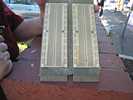
Here is Mike's DEC Q-BUS card, from e-bay, looking rather grungy.
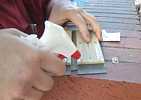
Squirting on plenty of isopropyl alcohol on the right hand side
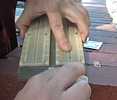
and rubbing vigorously.

Well, OK, it looks a little cleaner
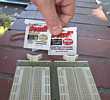
Here is the product Mike is touting

Applied to the left side, and a rub-a-dub-a-rub-a

And some discoloration on the paper from the board.
Go to August 2007
go to Team Bios
